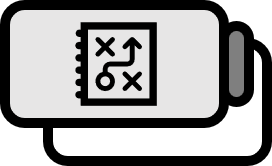Biomedical Informatics: DNA, RNA, Chromosomes
Buildup
- Polymers are high molecular compounds formed by the repeating connection of monomers through chemical synthesis.
- Phosphoric Acid is a type of inorganic oxyacid, with the chemical formula $H_{3}PO_{4}$.
- Monosaccharides with five carbon atoms are called Pentoses.
- Molecules that function as the basic unit of genetic information are called Nitrogenous bases, or simply Bases.
- A molecule composed of phosphate, pentose, and a base, serving as the building block of nucleic acids, is called a Nucleotide.
- Nucleic Acids, essential for biological phenomena, are polymers of nucleotides.
- The nucleic acid that forms a chain structure based on the pentose ribose is called Ribo Nucleic Acid (RNA).
- The nucleic acid with two long strands of nucleotide polymers twisted together in a double-helix structure is called Deoxyribo Nucleic Acid (DNA).
- DNA or RNA is referred to as Genetic Material.
Differences between DNA and RNA
These terms might seem insignificant on their own in the field of bioinformatics, but not knowing them might make you feel foolish, so it is recommended to look them up on Wikipedia in your free time.
The differences between DNA and RNA are as follows:
- DNA has base pairs making it double-stranded, and RNA is single-stranded. Thus, DNA is much more stable than RNA.
- DNA uses $A,T,C,G$ as major bases, while RNA uses $A,U,C,G$.
Definition
- A Chromosome is when the genetic material in a cell, scattered in the nucleus in the form of chromatin, becomes condensed.
Comparison with Base Sequence
Chromosomes are observed during cell division in eukaryotes, usually inherited one from each parent, forming a pair. In humans, there are 22 pairs of autosomes and one pair of XY sex chromosomes.
If you’re interested in understanding the differences between base sequences, think of DNA or RNA being twisted and clumped together to form chromosomes, while base sequences are like notes taken to read and write down information. Chromosomes are physical entities, whereas base sequences are data.
Even in bioinformatics, unless there is a specific interest in the physical structure, data analysts might not deal with chromosomes. However, it’s still important to know what each term refers to avoid confusion when dealing with DNA, RNA, genes, genomes, etc.
